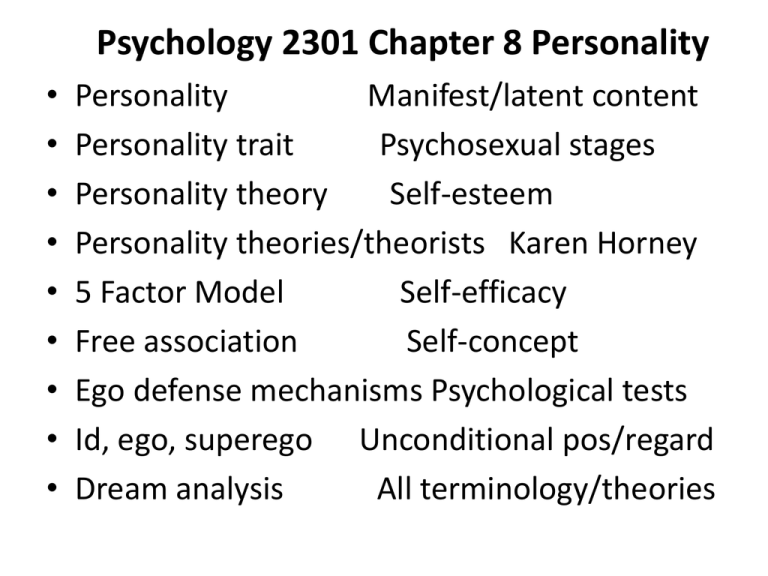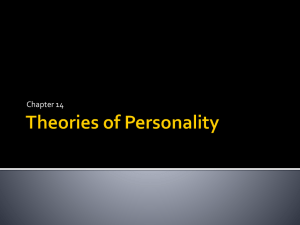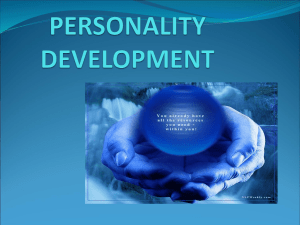
Psychology 2301 Chapter 8 Personality
•
•
•
•
•
•
•
•
•
Personality
Manifest/latent content
Personality trait
Psychosexual stages
Personality theory
Self-esteem
Personality theories/theorists Karen Horney
5 Factor Model
Self-efficacy
Free association
Self-concept
Ego defense mechanisms Psychological tests
Id, ego, superego Unconditional pos/regard
Dream analysis
All terminology/theories
Introduction: What Is Personality?
• Personality is an individual’s unique and relatively consistent
patterns of thinking, feeling, and behaving.
• A personality trait is a durable disposition to behave in a particular
way…excitable, moody, dependable, friendly
•
People are fairly consistent and stable with their
personalities…although, the bulk of personality changes appear
between the ages of 20 and 40 and the certain personality traits
may continue to experience changes well into old age
• Distinctiveness is also central to the theme of personality… not
adhering to the status quo…thinking outside the box
• A factor analysis correlates many variables and then analyzes them
to identify closely related clusters or variables
•
•
•
•
•
•
•
•
•
•
•
•
A personality theory is a theory that attempts to describe and explain similarities
and differences in people’s patterns of thinking, feeling, and behavior.
Personality theories can be roughly grouped under four basic perspectives:
1. The psychoanalytic perspective emphasizes the importance of unconscious
processes and the influence of early childhood experience.
2. The humanistic perspective represents an optimistic look at human nature,
emphasizing the self and the fulfillment of a person’s unique potential.
3. The social cognitive perspective emphasizes learning and conscious cognitive
processes, including the importance of beliefs about the self, goal setting, and selfregulation.
4. The trait perspective emphasizes the description and measurement of specific
personality differences among individuals.
The Five-Factor Model
• Many trait researchers believe that the essential building blocks of
personality can be described in terms of five basic personality dimensions,
sometimes called “the Big Five.”
•
• According to the five-factor model of personality, these five dimensions
(extraversion, neuroticism, agreeableness,
• conscientiousness, and openness to experience) represent the
• structural organization of personality traits or
•
• O C E A N
•
• 1. The five-factor structure of personality has been found in a variety of
cultures and may be universal.
• 2. Research has shown that traits are remarkably stable over time.
•
• 3. Traits are also generally consistent across different situations, but
situational influences may affect their expression. Human behavior is the
result of a complex interaction between traits and situations.
• There are correlations between the Big 5 personality traits and
↑GPA (higher conscientiousness…conscientious students work
harder)…↑ neuroticism ↑ divorce…↑ neuroticism and ↑ mental
disorders…↑ conscientiousness ↓ illness and mortality
•
• B. Two Representative Trait Theories: Raymond Cattell and Hans
Eysenck
•
• 1. Pioneer trait theorist Raymond Cattell used a statistical technique
called factor analysis to identify traits that were most closely
related to one another, eventually reducing his list to 16 key
personality factors.
•
• Cattell developed the widely used personality test, the Sixteen
• Personality Factor Questionnaire, or 16PF.
•
•
•
•
•
•
•
•
•
•
•
•
•
•
•
2. British psychologist Hans Eysenck developed a trait theory of personality that
includes three basic dimensions.
a. Introversion–extraversion is the degree to which a person directs his energies
outward toward the environment and other people versus inward toward his inner
and self-focused experiences.
(1) High on introversion—quiet, solitary, reserved; avoiding new experiences
(2) High on extraversion—outgoing and sociable; enjoying new
experiences and stimulating environments
b. Neuroticism–emotional stability refers to a person’s emotional predisposition.
(1) Neuroticism refers to a person’s predisposition to become
emotionally upset.
(2) Stability reflects a person’s predisposition to be emotionally
even.
• c. Psychoticism, the third major personality dimension, was identified by
Eysenck in later research.
•
• (1) A person high on this trait is antisocial, cold, hostile, and
• unconcerned about others.
•
• (2) A person who is low on psychoticism is warm and caring
• toward others.
•
• d. Eysenck believed that individual differences in personality are
• due to biological differences among people.
•
• Specific personality traits can produce individual differences in
• the brain’s reaction to emotional stimuli.
•
• Gordon Allport reduced the traits into 4,500 trait like words he organized
onto three levels according to importance…
• Cardinal traits-most important
• Central traits-the basic and most useful traits
• Secondary traits-the less obvious and less consistent traits
Leadership, a personality trait?
• One trait that has been studied in thousands of studies is
leadership, the ability to direct or inspire others to achieve
goals. Trait theories of leadership are theories based on the
idea that some people are simply “natural leaders” because
they possess personality characteristics that make them
effective.
• Research has found that being intelligent is an important
characteristic of leaders, as long as the leader
communicates to others in a way that is easily understood
by his or her followers.
• Other research has found that people with good social
skills, such as the ability to accurately perceive the needs
and goals of the group members and to communicate with
others, also tend to make good leaders.
Situational Influences on Personality
• Walter Mischel found that there was a low
correlation between traits that a person
expressed in one situation and those
expressed in other situations…child honesty test
• We have to be mindful not to assume that
traits remain stable under all circumstances
(remember Kohlberg’s moral dilemma)
• Traits tend to be more in the head of the
person who is judging…we tend to use human
traits to also judge animals
The Barnum Effect
• The Barnum effect refers to the observation
that people tend to believe in descriptions of
their personality that supposedly are
descriptive of them but could in fact describe
almost anyone…astronomy, horoscopes,
fortunetelling, palm reading, tarot card,
personality tests
• People are likely to accept description of their
personality if they think that they have been
written for them…reliance on traits; people
can express their traits in different ways
The Trait Perspective on Personality
• A trait theory of personality is one that focuses on identifying,
describing, and measuring individual differences in behavioral
predispositions.
• 1. Trait theorists view the person as a unique combination of
personality characteristics or attributes, called traits. A trait is a
relatively stable, enduring predisposition to behave in a certain way.
• 2. A trait is typically described in terms of a range from one extreme
to its opposite.
• 1. Surface traits are personality characteristics or attributes that
can be easily inferred from observable behavior.
• 2. Source traits are the most fundamental dimensions of
personality; they are the broad basic traits that are hypothesized to
be universal and relatively few in number. A source trait can give
rise to many surface traits.
• 1. Behavioral genetics studies the effects of genes and heredity on
behavior.
Psychological Tests
• Psychological tests assess a person’s abilities, aptitudes, interests, or
personality on the basis of a systematically obtained sample of behavior.
Any psychological test is useful insofar as it achieves two basic goals:
• 1. It accurately and consistently reflects a person’s characteristics on some
dimension.
• 2. It predicts a person’s future psychological functioning or behavior.
• A. Projective Tests: Like Seeing Things in the Clouds
• 1. Projective tests are personality tests that involves a person’s
interpreting an ambiguous image; they are used to assess unconscious
motives, conflicts, psychological defenses, and personality traits.
• a. The Rorschach Inkblot Test is a projective test using inkblots that was
developed by Swiss psychiatrist Hermann Rorschach in 1921.
• b. The Thematic Apperception Test (TAT) is a projective personality test
that involves creating stories about each of a series of ambiguous scenes.
II. The Psychoanalytic Perspective on Personality
Sigmund Freud
• The founder of psychoanalysis, was one of the
most influential figures of the twentieth
century.
•
• Psychoanalysis is the theory of personality
that emphasizes unconscious determinants of
behavior, sexual and aggressive instinctual
drives, and the enduring effects of early
childhood experience on later personality
development.
• b. Freud later dropped Breuer’s method of
using hypnosis and developed his own
technique of free association to help
• patients uncover forgotten memories.
•
• Freud’s patients would spontaneously report
their uncensored thoughts, mental images,
and feelings as they came to mind.
•
•
•
•
•
•
•
•
•
•
•
•
•
•
•
•
Freud’s Dynamic Theory of Personality
1. Freud saw personality and behavior as resulting from a constant interplay between conflicting
psychological forces that operate at three different levels of awareness.
a. All the thoughts, feelings, and sensations that you are aware of at this particular moment represent the
conscious level.
b. The preconscious contains information of which you’re not currently aware but is easily capable of
entering your consciousness, such as childhood memories or your Social Security number.
c. The bulk of Freud’s psychological iceberg is made up of the unconscious, which lies submerged below
the waterline of the preconscious and conscious. We are not directly aware of these
submerged thoughts, feelings, wishes, and drives, but the unconscious exerts an enormous influence on
our conscious thoughts and behavior.
d. Freud believed that unconscious material often seeps through to the conscious level in distorted,
disguised, or symbolic forms.
Dream analysis was important to Freud.
Beneath the surface images, or manifest content, of a dream lies its latent content, true, hidden,
unconscious meaning of the dream symbols.
e. The unconscious can also be revealed in unintentional actions, such as accidents, mistakes, instances of
forgetting, and inadvertent slips of the tongue, which are often referred to as “Freudian slips.”
• 2. The structure of personality
• Psychological energy evolves to form the three
basic structures of personality—the id, the
ego, and the superego. These are distinct
psychological processes.
• a. The id, the most primitive part of the
personality, is entirely unconscious and
present at birth. It is completely immune to
logic, values, morality, danger, and the
demands of the external world.
•
•
•
•
•
•
(2) The id is ruled by the pleasure principle—the relentless
drive toward immediate satisfaction of the instinctual urges,
especially sexual urges. Freud saw the pleasure principle as
the most fundamental human motive.
b. A new dimension of personality develops from part of the
id’s psychological energy—the ego.
•
• (1) Partly conscious, the ego represents the organized,
rational, and planning dimensions of personality. The
mediator between the id’s instinctual demands and the
restrictions of the outer world, the ego operates on the reality
principle.
•
• The reality principle is the capacity to postpone gratification
• until the appropriate time or circumstances exist in the
• external world.
• (2) The ego is the pragmatic part of the personality that learns
• various compromises to reduce the tension of the id’s instinctual
• urges.
•
•
•
•
•
•
•
•
If the ego cannot identify an acceptable compromise
to satisfy an instinctual urge, it can repress the impulse
or remove it from conscious awareness.
c. Gradually, social values move from being externally imposed
demands to being internalized rules and values. By about age
five or six, young children develop an internal, parental voice
that is partly conscious—the superego. As the internal
representation of parental and societal values, the superego
evaluates the acceptability of behavior and thoughts, then
praises or admonishes.
Ego Defense Mechanism
• 3. The ego defense mechanisms: Unconscious self-deceptions
• a. When the demands of the id or superego threaten to
overwhelm the ego, anxiety results.
•
• b. If a realistic solution or compromise is not possible, the ego
may temporarily reduce anxiety by distorting thoughts or
perceptions of reality through processes Freud called ego
defense mechanisms.
•
• By resorting to these largely unconscious self-deceptions,
• the ego can maintain an integrated sense of self while
searching for a more acceptable and realistic solution to a
conflict between the id and superego.
• (1) The most fundamental ego defense mechanism is repression, which is
unconscious forgetting. Unbeknownst to the person, anxiety-producing
thoughts, feelings, or impulses are pushed out of conscious awareness
into the unconscious.
•
• (2) Displacement occurs when emotional impulses are redirected to a
substitute object or person, usually one less threatening or dangerous
than the original source of conflict.
•
• (3) Sublimation is a special form of displacement which
• involves displacing sexual urges toward productive, socially
• acceptable, nonsexual activities. Freud believed sublimation
• was largely responsible for the productive and creative contributions of
people and even of whole societies.
•
• (4) Many psychologically healthy people temporarily use ego
• defense mechanisms to deal with stressful events; when they
• delay or interfere with our use of more constructive coping
• strategies, they can be counterproductive.
Personality Development: The Psychosexual Stages
• . According to Freud, people progress through five psychosexual stages of
development. The foundations of adult personality are established during
the first five years of life, as the child progresses through the oral, anal,
and phallic stages.
•
• The latency stage occurs during later childhood, and the fifth and final
stage, the genital stage, begins in adolescence.
•
• 2. The psychosexual stages are age-related developmental periods in
which sexual impulses are focused on different bodily zones and are
expressed through activities associated with those areas.
•
• a. Oral stage: During the first year of life, the infant derives pleasure
through the oral activities of sucking, chewing, and biting.
•
• b. Anal stage: Over the next two years, pleasure is derived through
elimination and acquiring control over elimination.
•
• c. Phallic stage: Pleasure seeking is focused on the genitals.
•
•
•
•
•
•
•
•
•
•
•
•
•
•
3. Fixation: Unresolved developmental conflicts
a. At each psychosexual stage, according to Freud, the infant or young child is faced with a
developmental conflict that must be successfully resolved in order to move on to the next
stage.
b. If frustrated, the child will be left with feelings of unmet needs characteristic of that
stage; if overindulged, the child may be reluctant to move on to the next stage. In either
case, the result of an unresolved developmental conflict is fixation at a particular stage.
4. The Oedipus complex: A psychosexual drama Freud believed that the most critical
conflict occurs during the phallic stage.
The Oedipus complex is a child’s unconscious sexual desire for the opposite-sex parent,
usually accompanied by hostile feelings toward the same-sex parent.
a. The little boy feels hostility and jealousy toward his father, but he realizes that his father
is more physically powerful. The boy experiences castration anxiety.
b. To resolve the Oedipus complex, the little boy ultimately joins forces with his former
enemy by resorting to the defense mechanism of identification; that is, he imitates and
internalizes his father’s values, attitudes, and mannerisms.
• c. The little girl discovers that little boys have a penis and that she
does not. She feels a sense of deprivation and loss that Freud
• termed penis envy. The little girl blames her mother and develops
contempt for and resentment toward her; however, in her attempt
to take her mother’s place with her father, she also
• identifies with her mother.
•
• 5. The latency and genital stages
• a. Freud believed that because of the intense anxiety associated
• with the Oedipus complex, the sexual urges of boys and girls
• become repressed during the latency stage in late childhood.
•
• b. Final resolution of the Oedipus complex occurs in adolescence,
during the genital stage. As incestuous urges start to resurface, they
are prohibited by the moral ideals of the superego as well as by
societal restrictions.
2. Carl Jung: Archetypes and the collective
unconscious
•
•
•
•
•
•
•
•
•
•
•
•
•
•
•
Swiss psychiatrist Carl Jung broke with Sigmund Freud to develop his own psychoanalytic theory of
personality. Jung believed that people are motivated by a more general psychological energy that
pushes them to achieve psychological growth, self-realization, and psychic wholeness and harmony.
He also believed that personality continues to develop in significant ways throughout the lifespan.
a. Jung believed that the deepest part of the individual psyche is
the collective unconscious, which is shared by all people and
reflects humanity’s collective evolutionary history.
b. Contained in the collective unconscious are the archetypes, the mental images of universal
human instincts, themes, and preoccupations.
c. Jung described two important archetypes: the anima (feminine) and the animus (masculine). To
achieve psychological harmony, Jung believed, men must recognize and accept their feminine
aspects and women must recognize and accept their masculine aspects.
d. Jung’s concepts of the collective unconscious and shared archetypes have been criticized as
unscientific or mystical.
e. Jung was the first to describe two basic personality types: introverts, who focus their attention
inward, and extraverts, who turn their attention and energy toward the outside world.
Alfred Adler: Feelings of inferiority and striving for
superiority
• Austrian physician Alfred Adler broke away from Freud to establish his
own theory of personality.
• a. Adler believed that the most fundamental human motive is striving for
superiority—the desire to improve oneself, master challenges, and move
toward self-perfection and self-realization.
•
• (1) This striving arises from universal feelings of inferiority.
•
• (2) These feelings motivate people to compensate for their real
• or imagined weaknesses.
•
• b. When people are unable to compensate for specific weaknesses or
when their feelings of inferiority are excessive, they can develop an
inferiority complex—a sense of inadequacy, weakness, and helplessness.
•
• c. At the other extreme, people can overcompensate for their feelings of
inferiority and develop a superiority complex.
Evaluating Freud and the Psychoanalytic Perspective on
Personality
• Although Freudian theory has had a profound impact on psychology and
on society, there are several valid criticisms.
• 1. Inadequacy of evidence
• 2. Lack of testability
• 3. Sexism
•
• a. Freud claimed women are more vain, masochistic, and jealous
• than men. He also believed that women are more influenced by
• their emotions and have a lesser ethical and moral sense.
• b. Horney and other female psychoanalysts have pointed out that
• Freud’s theory uses male psychology as a prototype. Women are
• essentially viewed as a deviation from the norm of masculinity.
• Fromm believed that the primary human motivation was to escape the
fear of death…our concerns about dying can influence our
behavior…people have been known to react aggressively when reminded
of the possibility of death
Behavioral Perspective
• Behaviorism is a theoretical orientation based on the premise that
scientific psychology should study only observable behavior
• Skinner’s principle of operant conditioning was not meant to be a
theory of personality, but his principles can be applied to
personality development
•
• People show some consistent patterns of behaviors because they
have some stable response tendencies that have been reinforced or
punished over time
•
• A specific situation may be associated with a number of response
tendencies that vary in strength, depending on past conditioning
•
• Response tendencies are constantly being strengthened or
weakened by new responses…personality development is a
continuous lifelong journey
• 1. Social cognitive theory emphasizes the social origins
of thoughts and actions but also stresses active
cognitive processes and the human capacity for selfregulation.
•
• 2. Bandura’s research has shown that we observe the
consequences that follow people’s actions, the rules
and standards that apply to behavior in specific
situations, and the ways in which people regulate their
own behavior.
•
• 3. Reciprocal determinism is a model proposed by
Bandura that explains human functioning and
personality as caused by the interaction of behavioral,
cognitive, and environmental factors.
•
• The most critical elements influencing the self-system
are our beliefs of self-efficacy, the degree to which we
are subjectively convinced of our own capabilities and
effectiveness in meeting the demands of a particular
situation.
•
• We acquire new behaviors and strengthen our beliefs
of selfefficacy in particular situations through
observational learning and mastery experiences.
•
• 4. Developing self-efficacy begins in childhood, but it
continues as a lifelong process, with each stage of the
lifespan presenting new challenges.
•
The Humanistic Perspective on Personality
• In opposition to both psychoanalysis and behaviorism was a “third
force” in psychology, called humanistic psychology.
•
• This view of personality emphasizes human potential and such
uniquely human characteristics as self-awareness and free will.
• It sees people as being innately good and focuses on the healthy
personality.
•
• 1. Humanistic psychologists contended that the most important
factor in personality is the individual’s conscious, subjective
perception of his or her self.
•
• 2. Abraham Maslow, one of the two most important contributors
to humanistic psychology developed the hierarchy of needs and the
concept of self-actualization.
•
•
•
•
•
•
•
•
•
•
•
•
1. The cornerstone of Rogers’s personality theory is the idea of the selfconcept,
which is the set of perceptions and beliefs that you have about yourself. As
children develop a greater sense of self-awareness, there is an increasing need for
positive regard—the sense of being loved and valued by other people.
a. Rogers maintained that most parents provide their children with conditional
positive regard—the sense that the child is valued and loved only when the child
behaves in a way that is acceptable to others. Incongruence is a state in which a
child’s self-concept conflicts with his or her actual experience.
b. Unconditional positive regard refers to the child’s sense of
being unconditionally loved and valued, even if she doesn’t conform to the
standards and expectations of others.
c. Rogers did not advocate permissive parenting. He maintained
that parents can disapprove of a child’s specific behavior without completely
rejecting the child herself.
2. Through consistent experiences of unconditional positive regard, one becomes a
psychologically healthy, fully functioning person who has a flexible, constantly
evolving self-concept.
Karen Horney
•
Karen Horney came to stress the importance of cultural and social factors and social
relationships (especially the parent–child relationship) in personality development.
•
a. Horney believed that disturbances in human relationships, not sexual conflicts, were
the cause of psychological problems. Such problems arise from the attempt to deal with
basic anxiety.
b. Horney described three patterns of behavior that individuals use to defend against
basic anxiety.
(1) Those who move toward other people have an excessive need for approval and
affection.
(2) Those who move against others have an excessive need for power.
(3) Those who move away from other people have an excessive need for independence
and self-sufficiency.
c. Horney contended that people with a healthy personality are flexible in balancing
these different needs.
d. Horney sharply disagreed with Freud’s notion that women suffer from penis envy.
She believed that what women envy in men is not their penis, but their superior status
in society. She contended that men often suffer womb envy—envying women’s capacity
to bear children. She argued that men compensated for their minor role in reproduction
by constantly striving to make creative achievements in their work.
e. Horney agreed with Jung that the drive to grow psychologically and achieve one’s
potential is a basic human motive.
•
•
•
•
•
•
•










